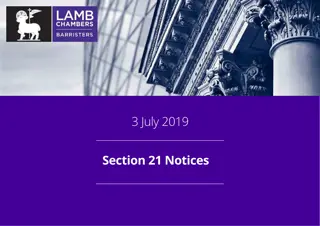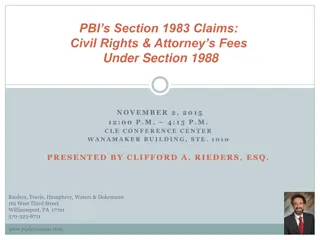
Government Revenue and State Spending: Overview of State Taxation
Learn about state government revenue sources such as sales and excise taxes, income tax, and other revenue streams. Discover how states manage their budgets through balanced budget requirements and operating versus capital budgets. Explore major state expenses like education and public safety.
Download Presentation

Please find below an Image/Link to download the presentation.
The content on the website is provided AS IS for your information and personal use only. It may not be sold, licensed, or shared on other websites without obtaining consent from the author. If you encounter any issues during the download, it is possible that the publisher has removed the file from their server.
You are allowed to download the files provided on this website for personal or commercial use, subject to the condition that they are used lawfully. All files are the property of their respective owners.
The content on the website is provided AS IS for your information and personal use only. It may not be sold, licensed, or shared on other websites without obtaining consent from the author.
E N D
Presentation Transcript
Chapter 14: Government Revenue and Spending Section 4: State and Local Taxes and Spending pgs.434-439
State Revenues http://www.nature-education.org/cart/map-texas-art.jpg The federal government has the broadest tax base, while the smallest tax base is at the local level. There are thousands of local government units, from towns, cities, and counties. State revenues come from a variety of sources, the largest is intergovernmental revenue. States also raise funds from state sales tax, both on individuals and on corporations.
State Revenues- Type 1 Sales & Excise Taxes In all states except Alaska, Delaware, New Hampshire, Montana, & Oregon levy a state sales tax. Here in Texas, our sales tax is 8.25% (.0825). Often charitable, religious, and educational organizations are exempt from paying taxes. All states have excise taxes on cigarettes, alcohol, gasoline, and diesel fuel. http://madworldnews.com/wp-content/uploads/2014/07/USA-Map-Only.jpg
State Revenues-Type 2 Income Tax & Other Revenue Sources http://i.infopls.com/images/mwyoming.gif http://www.mapofus.org/wp-content/uploads/2013/09/NV-county.jpg All states levy individual income tax except Alaska, Florida, South Dakota, Texas, and Washington. All states except for Nevada & Wyoming levy corporate income tax. Most states also have estate taxes, user fees, & property taxes. States also have fees related to business operation, like registration fees and license fees for doctors, dentists, lawyers, and accountants.
Balanced Budget http://thumbs.dreamstime.com/z/balanced-budget-d-words-scale-financial-costs-revenue-equal-gold-weighing-against-revenues-accounting-bookkeeping-45144681.jpg All states except Vermont are required to have a balanced budget, in which total government revenue from all sources is equal to total government spending. However, this usually only applies to certain kinds of spending. And most states have a surplus, which can be used in years of over spending.
State Budgets States actually work with two types of budgets an operating budget, which is a plan for day-to-day expenses, and a capital budget, which is a plan for major expenses or investments. The operating budget covers expenses such as salaries, health & welfare benefits, and funds for education and are usually operate on balanced budgets. Capital budgets provide funds for large construction and maintenance projects and don t operate on balanced budgets. http://www.ncsl.org/portals/1/ImageLibrary/Hero/BudgetsConditions.jpg
State Expenses Education is a major expense for states. They support community colleges, state universities, and pay for 49% of public school funding. Public safety is also a major expense. States also administer retirement funds for state employees. And finally public including housing, disability, unemployment, and job training is a big expense. http://www.rcssc.org/images/bremond.jpg
Local Revenue & Spending Local government units include counties, cites, towns, villages, townships, school districts, and other special districts. Their major sources of revenue are intergovernmental revenue or transfers from state & federal governments and property taxes. They also have smaller taxes on individual & corporate taxes and sales tax. https://www21.corecommerce.com/~texasslavgerman/uploads/image/map_large.jpg
Property Tax http://ecx.images-amazon.com/images/I/41291PY3AJL.jpg This is a tax that is levied on real estate and on personal property such as motor vehicles, boats, expensive jewelry, or computers. Local governments rely on a tax assessor, a government official who determines the value of the property. They then enact a tax bases on a percentage of the property s value.
Other Local Taxes Local governments also use sales taxes, sin taxes on activities such as gambling, hospitality taxes on hotels, and restaurants, entertainment taxes on tickets or entrance fees, and payroll taxes. The local payroll taxes are taxes on peoples pay check that work in the city but live in the suburbs. http://www.travelandleisure.com/sites/default/files/styles/1600x1000/public/images/amexpub/0030/1223/201206-a-trip-doctor-hotel-taxes.jpg?itok=4Gs8O0hg
Local Spending Local governments provide most of the direct services that citizens receive. Public Schools about 46% of local government spending goes to education. Public Safety Local governments provide police and fire protection. Public Welfare many local governments maintain public health departments, and some operate their own hospitals. Other Responsibilities like public utilities such as water, public transit, sewage systems and trash removal. They also maintain local highways, roads, & streets, including traffic control lights & signs, snow removal, and pothole repair. Finally, local governments provide parks, pools, & libraries. http://librarytechnology.org/photos-libraries/24824.jpg






